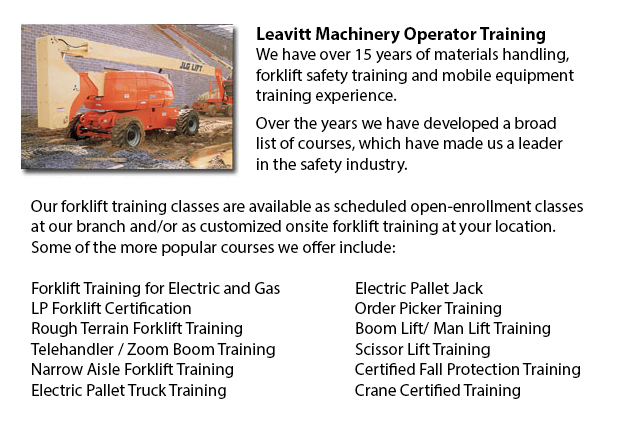
Aerial Boom Lift Training Vaughan - For people who operate or supervise the use of aerial lift platforms, correct aerial boom lift Training is essential. The aerial lift platform is used for lifting individuals, tools and materials to elevated work locations. They are normally used to access utility lines and other above ground job-sites. There are various types of aerial booms lifts, like extension boom lifts, cherry pickers and articulating boom lifts. There are two categories of boom lift: "knuckle" and "telescopic".
Training in the fundamental equipment, safety and operations concerns involved in boom lifts is important. Employees should know the dangers, safe work practices and rules while working among mobile equipment. Training course materials provide an introduction to the applications, terminology, concepts and skills needed for workers to obtain experience in operating boom lifts. The material is aimed at workers, equipment operators and safety experts.
For your business needs, this training is adaptive, cost-effective and educational and will help your workplace become more effective and safer, allowing for higher levels of production. Less workplace incidents take place in workplaces with stringent safety policies. All machine operators must be trained and assessed. They need understanding of present safety measures. They should understand and adhere to rules set forth by the local governing authorities and their employer.
Employers should make sure that their workers who operate aerial boom lifts get proper training in their safe use. Operator certification is required on every different type of aerial machine utilized in the workplace. Certifications are offered for articulating booms, aerial work platforms, scissor lifts, industrial forklift trucks, and so on. Employees who are fully trained work more effectively and efficiently compared to untrained workers, who need more supervision. Proper instruction and training saves resources in the long run.
Training is the best prevention for the main causes of workplace fatalities: falls, electrocutions and collapses or tip overs. Aside from training, the best way to avoid workplace accidents is to operate and maintain aerial work platforms based on the instructions of the manufacturer. Allow for the combined weight of the materials, worker and tools when following load restrictions. Never override hydraulic, mechanical or electrical safety devices. Workers should be held securely in the basket utilizing a restraining belt or body harness with an attached lanyard. Do not move lift equipment when workers are on the elevated platform. Employees must be careful not to position themselves between the joists or beams and basket rails in order to avoid being crushed. Energized overhead power lines should be at least 10 feet away from the lift machine. It is suggested that workers always assume wires and power lines may be energized, even if they seem to be insulated or are down. Set the brakes and utilize wheel chocks if working on an incline.
-
Forklift License Vaughan
Forklift License Vaughan - Getting a forklift certification or forklift license in North America would require the trainee to do hands-on training in addition to classroom instruction. The provincial, federal and state regulatory bodies are responsib... More -
Forklift Ticket Vaughan
Forklift Ticket Vaughan - Forklifts and the pallet jack is meant for just about the same reason. They work to raise and move supplies and goods from one place to another. This however is where the comparison stops though. With the pallet jack, the be... More -
Aerial Lift Certification Vaughan
Aerial Lift Certification Vaughan - Aerial Lift Certification is for individuals who need an in-depth understanding of aerial lift safety. Operators and inspectors, supervisors, maintenance workers and construction craftsmen should perform a certific... More -
Manlift Certification Vaughan
Manlift Certification Vaughan - The Manlifts and Elevated Platforms course provides training on the rules, regulations and proper application of safe operating measures and work practices included in everyday activities for those who work making use... More -
Heavy Equipment Training Vaughan
Heavy Equipment Training Vaughan - The two most common kinds of heavy equipment training are categorized into the categories of machines; equipment that is fashioned with rubber tires or those with tracks. The tracked vehicle are heavy duty machines... More -
Boom Lift Ticket Vaughan
Boom Lift Ticket Vaughan - Boom lifts are equipment that has a platform that may be lowered or raised to different heights, thus making this piece of equipment an important necessity in a wide variety of professions. Offered in many different particu... More -
Telehandler License Vaughan
Telehandler License Vaughan - The telescopic handler or telehandler is a frequently used equipment in industrial and agricultural applications. This particular machine is the same in appearance to a forklift and also functions in a similar way, altho... More -
Scissor Lift Training Vaughan
Scissor Lift Training Vaughan - Scissor lifts have to be operated competently to be able to protect the safety of the machinery and the safety of others within the workplace. Operators who are skilled are trained to drive the particular kind of sciss... More

Forklift Training Vaughan
TOLL FREE: 1-888-254-6157
Vaughan, Ontario
forklifttrainingvaughan.com
Email Us
About Us


